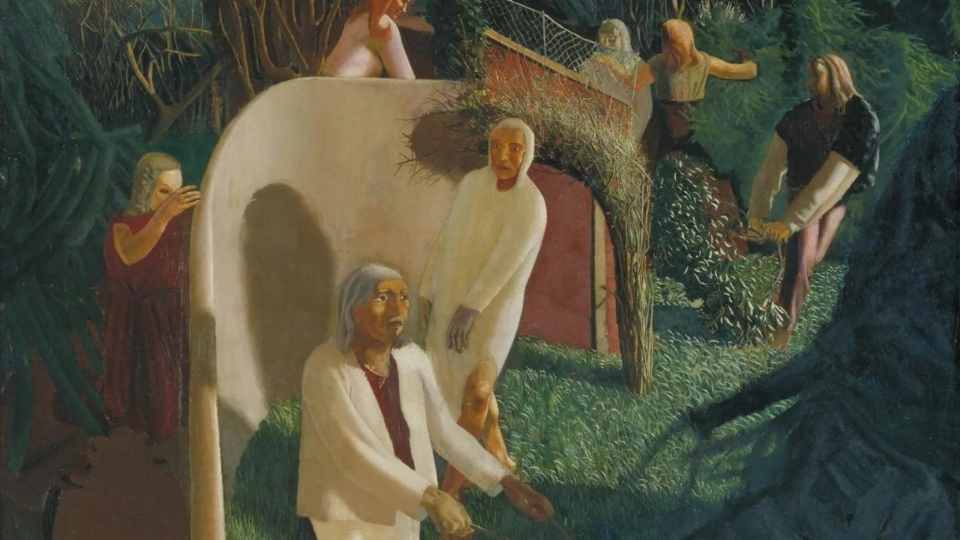
In art, as in all areas of life, representation matters.
When we can see ourselves in the art, or when we know that someone with a similar worldview and experience as our own is behind the art, we connect differently.
The July announcement that two heirs of Kansas City artist and educator Leonard Pryor (1924-2015) have given five of their father’s paintings to The Nelson-Atkins Museum of Art brings joy. That emotion is not just because more people get to enjoy Pryor’s works, although that would be enough to celebrate. The mere existence of the pieces in The Nelson’s collection means that more people can connect more deeply to more pieces of art at The Nelson thanks to representation.
Pryor, who dedicated his career to advocating for the arts and worked tirelessly to enrich Kansas City’s creative community, was a trailblazer.
“He was the first Black student enrolled at the Kansas City Art Institute, he organized exhibitions of Black artists and he was also the first Black to be named Dean of Students at KCAI,” said Julián Zugazagoitia, Menefee D. and Mary Louise Blackwell CEO & Director of the Nelson-Atkins. “His contributions were truly groundbreaking, and we are deeply grateful to his children for reaching out to the museum regarding their desire to preserve their father’s legacy.”
The five paintings given by Reneé Pryor Newton and Craig Pryor are North End (1950), Lonesome (1950), After the Bath (1949), Elsie Mountain (1950) and Still Life with Pear (1958).
“This important acquisition aligns with the museum’s commitment to diversity, equity, and inclusion while also furthering the goal of providing opportunities for visitors to both see themselves reflected in the collection and build empathy through direct experiences with art,” said Stephanie Fox Knappe, Samuel Sosland Senior Curator, American Art.
As I pondered this idea of representation and empathy, I went back to the Gospel story.
I thought about the many ways God could have saved humanity from sin without ever sending Jesus in human form. But it connects differently, doesn’t it, that God became human, walked the earth, built relationships and went to the cross alongside other people? We connect with the humanness, the pain, the relationships, the joys, the ideas of flipping tables or cursing trees when people are being ridiculous. It wouldn’t have been the same if the issue of sin was addressed differently. It would have likely felt less personal.
In a same, but different way, not having representation in a museum would hit differently. We learn from experiencing a blend of work from artists who think and look like us and those who are different. So, as the museum continues to expand the collection to be more even diverse – in terms cultures, contexts and eras that are the same as or different from our own – we have more opportunities to experience the multiethnic mosaic that is God’s creation. We have reason to celebrate.
North End and Lonesome are currently on view in Gallery 219 in the suite of galleries dedicated to historic American art with plans to highlight the other gifts in the future.
As you visit the paintings, consider engaging in Visio Divina. A guide is found below.
Visio Divina is translated from Latin as “divine seeing.” It is related to the prayer form Lectio Divina (divine reading). But instead of Scripture, this form of prayer uses visual elements to help set your mind on prayer. It allows God to speak into your heart through the image.
You are invited to experience this image below through Visio Divina. You can also continue on to read a devotional related to the passage of scripture and piece of art.
Visio Divina Questions:
What thoughts or feelings does this image evoke? Is there something God wants you to see? To hear?
What kind of prayer rises within you as you ponder this work? Go ahead and express that to God now.
The Nelson-Atkins Museum of Art
COST
Free!
RESERVATIONS
Reservations are required for non-members. Make a reservation here: https://cart.nelson-atkins.org/events/admission,32967
ADDRESS
4525 Oak Street, Kansas City, MO 64111
CONTACT
816-751-1278
ask@nelson-atkins.org


